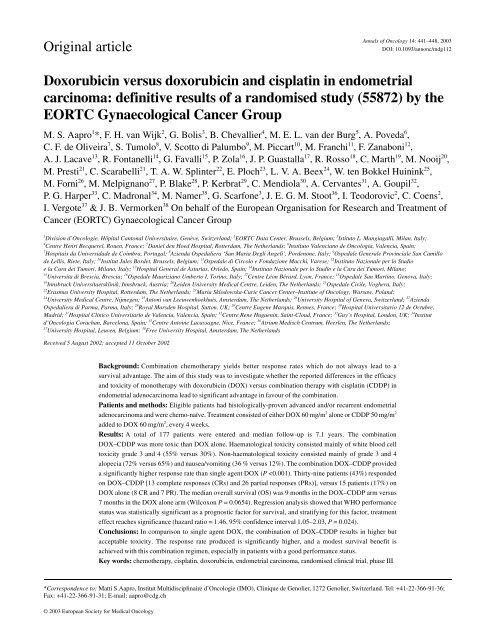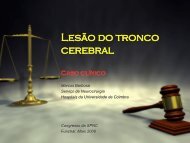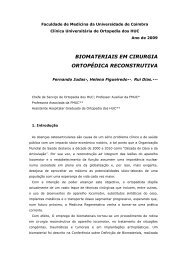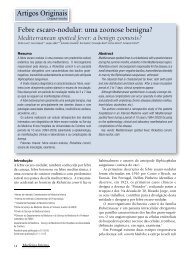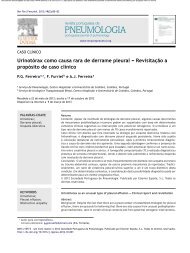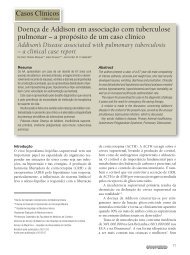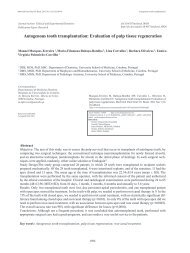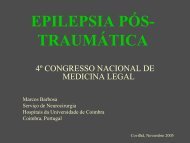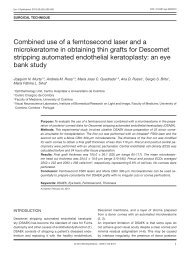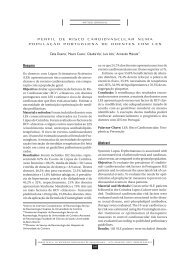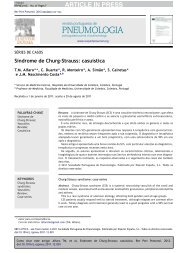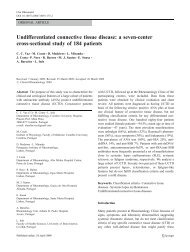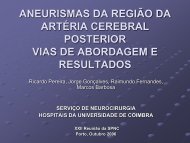Doxorubicin versus doxorubicin and cisplatin in endometrial ...
Doxorubicin versus doxorubicin and cisplatin in endometrial ...
Doxorubicin versus doxorubicin and cisplatin in endometrial ...
You also want an ePaper? Increase the reach of your titles
YUMPU automatically turns print PDFs into web optimized ePapers that Google loves.
Orig<strong>in</strong>al article<br />
Annals of Oncology 14: 441–448, 2003<br />
DOI: 10.1093/annonc/mdg112<br />
<strong>Doxorubic<strong>in</strong></strong> <strong>versus</strong> <strong>doxorubic<strong>in</strong></strong> <strong>and</strong> <strong>cisplat<strong>in</strong></strong> <strong>in</strong> <strong>endometrial</strong><br />
carc<strong>in</strong>oma: def<strong>in</strong>itive results of a r<strong>and</strong>omised study (55872) by the<br />
EORTC Gynaecological Cancer Group<br />
M. S. Aapro 1 *, F. H. van Wijk 2 , G. Bolis 3 , B. Chevallier 4 , M. E. L. van der Burg 5 , A. Poveda 6 ,<br />
C. F. de Oliveira 7 , S. Tumolo 8 , V. Scotto di Palumbo 9 , M. Piccart 10 , M. Franchi 11 , F. Zanaboni 12 ,<br />
A. J. Lacave 13 , R. Fontanelli 14 , G. Favalli 15 , P. Zola 16 , J. P. Guastalla 17 , R. Rosso 18 , C. Marth 19 , M. Nooij 20 ,<br />
M. Presti 21 , C. Scarabelli 21 , T. A. W. Spl<strong>in</strong>ter 22 , E. Ploch 23 , L. V. A. Beex 24 , W. ten Bokkel Hu<strong>in</strong><strong>in</strong>k 25 ,<br />
M. Forni 26 , M. Melpignano 27 , P. Blake 28 , P. Kerbrat 29 , C. Mendiola 30 , A. Cervantes 31 , A. Goupil 32 ,<br />
P. G. Harper 33 , C. Madronal 34 , M. Namer 35 , G. Scarfone 3 , J. E. G. M. Stoot 36 , I. Teodorovic 2 , C. Coens 2 ,<br />
I. Vergote 37 & J. B. Vermorken 38 On behalf of the European Organisation for Research <strong>and</strong> Treatment of<br />
Cancer (EORTC) Gynaecological Cancer Group<br />
1 Division d’Oncologie, Hôpital Cantonal Universitaire, Genève, Switzerl<strong>and</strong>; 2 EORTC Data Center, Brussels, Belgium; 3 Istituto L. Mangiagalli, Milan, Italy;<br />
4 Centre Henri Becquerel, Rouen, France; 5 Daniel den Hoed Hospital, Rotterdam, The Netherl<strong>and</strong>s; 6 Instituto Valenciano de Oncologia, Valencia, Spa<strong>in</strong>;<br />
7 Hospitais da Universidade de Coimbra, Portugal; 8 Azienda Ospedaliera ‘San Maria Degli Angeli’, Pordenone, Italy; 9 Ospedale Generale Prov<strong>in</strong>ciale San Camillo<br />
de Lellis, Riete, Italy; 10 Institut Jules Bordet, Brussels, Belgium; 11 Ospedale di Circolo e Fondazione Macchi, Varese; 12 Instituto Nazionale per lo Studio<br />
e la Cura dei Tumori, Milano, Italy; 13 Hospital General de Asturias, Oviedo, Spa<strong>in</strong>; 14 Instituto Nazionale per lo Studio e la Cura dei Tumori, Milano;<br />
15 Universita di Brescia, Brescia; 16 Ospedale Mauriziano Umberto I, Tor<strong>in</strong>o, Italy; 17 Centre Léon Bérard, Lyon, France; 18 Ospedale San Mart<strong>in</strong>o, Genova, Italy;<br />
19 Innsbruck Universitaetskl<strong>in</strong>ik, Innsbruck, Austria; 20 Leiden University Medical Centre, Leiden, The Netherl<strong>and</strong>s; 21 Ospedale Civile, Voghera, Italy;<br />
22 Erasmus University Hospital, Rotterdam, The Netherl<strong>and</strong>s; 23 Maria Sklodowska-Curie Cancer Center–Institute of Oncology, Warsaw, Pol<strong>and</strong>;<br />
24 University Medical Centre, Nijmegen; 25 Antoni van Leeuwenhoekhuis, Amsterdam, The Netherl<strong>and</strong>s; 26 University Hospital of Geneva, Switzerl<strong>and</strong>; 27 Azienda<br />
Ospedaliera di Parma, Parma, Italy; 28 Royal Marsden Hospital, Sutton, UK; 29 Centre Eugene Marquis, Rennes, France; 30 Hospital Universitario 12 de Octubre,<br />
Madrid; 31 Hospital Cl<strong>in</strong>ico Universitario de Valencia, Valencia, Spa<strong>in</strong>; 32 Centre Rene Huguen<strong>in</strong>, Sa<strong>in</strong>t-Cloud, France; 33 Guy’s Hospital, London, UK; 34 Institut<br />
d’Oncologia Corachan, Barcelona, Spa<strong>in</strong>; 35 Centre Anto<strong>in</strong>e Lacassagne, Nice, France; 36 Atrium Medisch Centrum, Heerlen, The Netherl<strong>and</strong>s;<br />
37 University Hospital, Leuven, Belgium; 38 Free University Hospital, Amsterdam, The Netherl<strong>and</strong>s<br />
Received 5 August 2002; accepted 11 October 2002<br />
Background: Comb<strong>in</strong>ation chemotherapy yields better response rates which do not always lead to a<br />
survival advantage. The aim of this study was to <strong>in</strong>vestigate whether the reported differences <strong>in</strong> the efficacy<br />
<strong>and</strong> toxicity of monotherapy with <strong>doxorubic<strong>in</strong></strong> (DOX) <strong>versus</strong> comb<strong>in</strong>ation therapy with <strong>cisplat<strong>in</strong></strong> (CDDP) <strong>in</strong><br />
<strong>endometrial</strong> adenocarc<strong>in</strong>oma lead to significant advantage <strong>in</strong> favour of the comb<strong>in</strong>ation.<br />
Patients <strong>and</strong> methods: Eligible patients had histologically-proven advanced <strong>and</strong>/or recurrent <strong>endometrial</strong><br />
adenocarc<strong>in</strong>oma <strong>and</strong> were chemo-naïve. Treatment consisted of either DOX 60 mg/m 2 alone or CDDP 50 mg/m 2<br />
added to DOX 60 mg/m 2 , every 4 weeks.<br />
Results: A total of 177 patients were entered <strong>and</strong> median follow-up is 7.1 years. The comb<strong>in</strong>ation<br />
DOX–CDDP was more toxic than DOX alone. Haematological toxicity consisted ma<strong>in</strong>ly of white blood cell<br />
toxicity grade 3 <strong>and</strong> 4 (55% <strong>versus</strong> 30%). Non-haematological toxicity consisted ma<strong>in</strong>ly of grade 3 <strong>and</strong> 4<br />
alopecia (72% <strong>versus</strong> 65%) <strong>and</strong> nausea/vomit<strong>in</strong>g (36 % <strong>versus</strong> 12%). The comb<strong>in</strong>ation DOX–CDDP provided<br />
a significantly higher response rate than s<strong>in</strong>gle agent DOX (P
442<br />
Introduction<br />
Endometrial cancer rema<strong>in</strong>s one of the commonest gynaecological<br />
malignancies. Whilst many patients with early stage disease<br />
are cured by either surgery or radiotherapy, or a comb<strong>in</strong>ation<br />
of the two [1], 40% of patients are either not amenable to such<br />
treatment due to metastatic disease, or subsequently relapse<br />
follow<strong>in</strong>g primary treatment. Such patients require systemic<br />
therapy <strong>in</strong> the form of either hormonal or cytotoxic therapy [2–6].<br />
Although the latter has been less extensively studied <strong>in</strong> <strong>endometrial</strong><br />
cancer, it is has been shown that response rates with<br />
s<strong>in</strong>gle-agent chemotherapy are comparable with those observed<br />
follow<strong>in</strong>g hormonal treatment, <strong>and</strong> response duration is generally<br />
longer. Thus there is a need to def<strong>in</strong>e the optimal chemotherapy<br />
regime. Whilst several phase II trials have identified chemotherapeutic<br />
s<strong>in</strong>gle agents with demonstrable objective response <strong>in</strong><br />
<strong>endometrial</strong> adenocarc<strong>in</strong>oma, of which <strong>doxorubic<strong>in</strong></strong> (DOX) <strong>and</strong><br />
<strong>cisplat<strong>in</strong></strong> (CDDP) seem to be the most active s<strong>in</strong>gle agents [2–6],<br />
the reported series are small <strong>and</strong> <strong>in</strong>clude patients with widelyvary<strong>in</strong>g<br />
pre-treatment conditions, together with variable response<br />
criteria.<br />
As the comb<strong>in</strong>ation of <strong>doxorubic<strong>in</strong></strong> <strong>and</strong> <strong>cisplat<strong>in</strong></strong> (DOX–CDDP)<br />
has been shown to be of benefit <strong>in</strong> treat<strong>in</strong>g other gynaecological<br />
malignancies [7], the current study, a multi-centre prospective<br />
r<strong>and</strong>omised trial, was designed to compare comb<strong>in</strong>ation therapy<br />
with DOX–CDDP <strong>versus</strong> DOX alone <strong>in</strong> <strong>endometrial</strong> carc<strong>in</strong>oma.<br />
Patients <strong>and</strong> methods<br />
Trial design<br />
This protocol was designed as a r<strong>and</strong>omised phase II/III study to determ<strong>in</strong>e<br />
the antitumour activity of comb<strong>in</strong>ation DOX–CDDP, <strong>versus</strong> s<strong>in</strong>gle-agent<br />
DOX, <strong>in</strong> patients with advanced primary <strong>endometrial</strong> cancer (i.e. beyond the<br />
stage of local treatment), <strong>and</strong> <strong>in</strong> those with recurrent disease. The second<br />
objective was to determ<strong>in</strong>e the toxicity of both treatment arms <strong>in</strong> comparable<br />
patients.<br />
Eligibility<br />
Patients eligible for this study were those with histologically-proven<br />
advanced <strong>and</strong>/or recurrent adenocarc<strong>in</strong>oma of the corpus uteri, all of whom<br />
were first considered for radiotherapy <strong>and</strong> all of those with well differentiated<br />
tumours for hormone therapy. Eligibility criteria were as follows: measurable<br />
or evaluable lesions outside previously irradiated areas, with documented<br />
progression; age ≤75 years; life expectancy ≥3 months; World Health Organization<br />
(WHO) performance status ≤2; <strong>and</strong> adequate bone marrow, renal <strong>and</strong><br />
liver function. All patients gave <strong>in</strong>formed consent.<br />
Excluded patients were those with the follow<strong>in</strong>g: prior chemotherapy,<br />
radiotherapy or hormone therapy with<strong>in</strong> 4 weeks of trial entry; unresolved<br />
toxic manifestations of their prior treatment; a concomitant or prior second<br />
cancer, other than adequately-treated basal or squamous cell carc<strong>in</strong>oma of the<br />
sk<strong>in</strong>; bra<strong>in</strong> or leptomen<strong>in</strong>geal <strong>in</strong>volvement; pleural effusion, ascites, bone<br />
lesions detectable only by bone scan or sclerotic bone metastases as the s<strong>in</strong>gle<br />
tumour response parameter; poor medical risk due to non-malignant disease,<br />
such as active bacterial or other <strong>in</strong>fection, heart failure or uncontrolled hypertension;<br />
<strong>and</strong> expected difficulty with follow-up.<br />
Basel<strong>in</strong>e <strong>in</strong>vestigations <strong>in</strong>cluded a medical history <strong>and</strong> physical gynaecological<br />
exam<strong>in</strong>ation, assessment of performance status, laboratory profile,<br />
ur<strong>in</strong>alysis, electrocardiogram, cl<strong>in</strong>ical <strong>and</strong>/or radiological measurement of<br />
<strong>in</strong>dicator lesion(s), computed tomography (CT) scan or ultrasound.<br />
Treatment <strong>and</strong> dose adjustments<br />
Treatment consisted of DOX 60 mg/m 2 <strong>and</strong> CDDP 50 mg/m 2 or DOX 60 mg/m 2<br />
every 4 weeks. Cisplat<strong>in</strong> was only given after adequate diuresis had been<br />
obta<strong>in</strong>ed with prehydration. Ancillary treatment was given as medically<br />
<strong>in</strong>dicated. Radiotherapy was allowed concomitantly for control of bone pa<strong>in</strong><br />
or other reasons, provided that all evaluable lesions were not <strong>in</strong>cluded <strong>in</strong> the<br />
irradiated field.<br />
The drug cycle was delayed by 1 week if toxicity persisted at the day of the<br />
next cycle. If the treatment had to be delayed for two consecutive weeks, the<br />
follow<strong>in</strong>g dose adjustments were made: if the white blood cell (WBC) count<br />
was 2.0–2.9 × 10 9 /l or the platelet count 50–99 × 10 9 /l, the DOX dose was<br />
reduced to 50% <strong>and</strong> the CDDP dose rema<strong>in</strong>ed at 100%; patients went off<br />
study if the WBC was
443<br />
diameter of all evaluable lesions, as determ<strong>in</strong>ed by two observations not less<br />
than 4 weeks apart, without progression or new lesions. There also had to be<br />
an objective improvement <strong>in</strong> non-evaluable but cl<strong>in</strong>ically evident malignant<br />
disease, <strong>and</strong> no <strong>in</strong>crease of any manifestations of malignant disease. No<br />
change was def<strong>in</strong>ed as a reduction of less than 50%, or an <strong>in</strong>crease of less than<br />
25%, <strong>in</strong> the size of one or more measurable lesions, without evidence of either<br />
new lesions or an <strong>in</strong>crease <strong>in</strong> any manifestation of malignant disease, until the<br />
first evaluation date. Progression of disease was def<strong>in</strong>ed as an <strong>in</strong>crease of<br />
greater than 25% <strong>in</strong> the size of one or more measurable lesions, or the appearance<br />
of a new lesion, <strong>and</strong> also by the occurrence of positive cytology of pleural<br />
effusion or ascitic fluid. Early progressive disease was def<strong>in</strong>ed as<br />
progression that occurred after one cycle. Early tumour death was def<strong>in</strong>ed as<br />
death occurr<strong>in</strong>g dur<strong>in</strong>g the first 8 weeks due to tumour progression, whilst<br />
toxic death was def<strong>in</strong>ed as death to which drug toxicity was thought to have<br />
made a major contribution.<br />
Statistical considerations<br />
The trial was designed as a r<strong>and</strong>omised phase II trial to be extended <strong>in</strong>to a<br />
comparative phase III trial <strong>in</strong> the case of sufficient responses. The phase II<br />
part of the trial required a m<strong>in</strong>imum of 20 patients <strong>in</strong> each arm, with five<br />
patients to be added per each response observed dur<strong>in</strong>g the first step. With<br />
respect to the comparative phase III part of the trial, it was assumed that the<br />
median duration of survival <strong>in</strong> the control (DOX) arm would be 8 months, <strong>and</strong><br />
the addition of CDDP would be justified if it could <strong>in</strong>crease the median duration<br />
of survival to 1 year. A total of 192 deaths were required to detect such a<br />
difference, with a two-sided type I error of 0.05 <strong>and</strong> a power of 80% [8]. Dur<strong>in</strong>g<br />
r<strong>and</strong>omisation, patients were stratified accord<strong>in</strong>g to <strong>in</strong>stitution, degree of<br />
differentiation (well <strong>versus</strong> moderate/poor), type of disease (locally advanced<br />
<strong>versus</strong> recurrent) <strong>and</strong> performance status, us<strong>in</strong>g the m<strong>in</strong>imisation technique<br />
[9]. Survival curves were estimated us<strong>in</strong>g the Kaplan–Meier technique [10].<br />
Duration of survival, time to progression (TTP) <strong>and</strong> progression-free survival<br />
(PFS) were compared between both treatment arms us<strong>in</strong>g a two-sided logrank<br />
test [11]. Cox’s proportional hazards model was used, retrospectively<br />
stratified for differentiation, type of disease <strong>and</strong> performance status [12].<br />
Response rates were compared us<strong>in</strong>g chi-square tests; the percentages <strong>in</strong> the<br />
tables are exact, whilst those <strong>in</strong> the text are rounded for clarity.<br />
Results<br />
Patient characteristics<br />
From September 1988 to June 1994, 177 patients with advanced<br />
<strong>in</strong>operable or recurrent <strong>endometrial</strong> cancer were r<strong>and</strong>omised by<br />
35 <strong>in</strong>stitutions, with 90 patients <strong>in</strong> the DOX–CDDP comb<strong>in</strong>ation<br />
arm <strong>and</strong> 87 <strong>in</strong> the s<strong>in</strong>gle-agent DOX arm. The study was stopped<br />
early as recruitment decreased dramatically after the publication<br />
of the Gynecologic Oncology Group results <strong>in</strong> 1993. Five<br />
patients had no follow-up data (three, DOX–CDDP; two, DOX).<br />
Twelve patients were found to be <strong>in</strong>eligible either due to <strong>in</strong>adequate<br />
disease stage (two, DOX–CDDP; two, DOX), absence of<br />
measurable lesions (one, DOX–CDDP; three, DOX), the lesions<br />
all be<strong>in</strong>g <strong>in</strong> a prior irradiated area (one, DOX–CDDP; one,<br />
DOX), bad physical condition (one, DOX–CDDP) or prior treatment<br />
(one, DOX).<br />
Basel<strong>in</strong>e characteristics of all patients are shown <strong>in</strong> Table 1;<br />
these were similar <strong>in</strong> both treatment arms. Median age was<br />
63 years (range 40–76) <strong>and</strong> 79% of all patients had a WHO performance<br />
status of 0 or 1. International Federation of Gynecology<br />
<strong>and</strong> Obstetrics (FIGO) stage at <strong>in</strong>itial diagnosis was stage IV <strong>in</strong><br />
25% of patients. The tumour was well differentiated <strong>in</strong> 19% of<br />
patients, <strong>and</strong> 59% had recurrent disease. Treatment received prior<br />
to this protocol <strong>in</strong>cluded surgery <strong>in</strong> 85% of patients, radiotherapy<br />
<strong>in</strong> 50% (23% of patients had had a response), hormone therapy <strong>in</strong><br />
23% <strong>and</strong> chemotherapy <strong>in</strong> 1%.<br />
Extent of exposure<br />
A total of 790 cycles were given to all patients, with 480 to<br />
patients <strong>in</strong> the DOX–CDDP arm, with a median of six cycles<br />
(range 0–15), <strong>and</strong> 310 to patients <strong>in</strong> the DOX arm, with a median<br />
of three cycles (range 0–7). DOX was given <strong>in</strong> 740 cycles: 430 <strong>in</strong><br />
the comb<strong>in</strong>ation arm <strong>and</strong> 310 <strong>in</strong> the s<strong>in</strong>gle-agent arm. DOX was<br />
delayed <strong>in</strong> 25 cycles (6%) <strong>in</strong> the comb<strong>in</strong>ation arm, <strong>and</strong> <strong>in</strong> 13 cycles<br />
(4%) <strong>in</strong> the s<strong>in</strong>gle-agent arm. DOX reductions were ma<strong>in</strong>ly made<br />
<strong>in</strong> the comb<strong>in</strong>ation arm (13% <strong>versus</strong> 5%). CDDP was given <strong>in</strong><br />
480 cycles, with a delay reported <strong>in</strong> 33 cycles (7%) <strong>and</strong> a dose<br />
reduction <strong>in</strong> 12 cycles (3%). In a s<strong>in</strong>gle <strong>in</strong>stance, the DOX <strong>and</strong><br />
CDDP doses were both escalated <strong>in</strong> the comb<strong>in</strong>ation arm, with no<br />
escalation reported <strong>in</strong> the s<strong>in</strong>gle-agent DOX arm.<br />
Toxicity<br />
Toxicity evaluation was based on the 165 patients (83 DOX–<br />
CDDP <strong>and</strong> 82 DOX) who received at least one cycle. The comb<strong>in</strong>ation<br />
DOX–CDDP was more toxic than DOX alone. Haematological<br />
toxicities are presented <strong>in</strong> Table 2. The median WBC<br />
nadir was 1.9 × 10 3 /mm 3 (range 0.2–17.7) <strong>in</strong> the DOX–CDDP<br />
arm, <strong>and</strong> 2.6 × 10 3 /mm 3 (range 0.1–10.2) <strong>in</strong> the DOX arm. The<br />
median platelet count nadir was 147 × 10 3 /mm 3 (range 11–720) <strong>in</strong><br />
the DOX–CDDP arm, <strong>and</strong> 232 × 10 3 /mm 3 (range 26–538) <strong>in</strong> the<br />
DOX arm. WBC toxicity grade 3 <strong>and</strong> 4 was noted <strong>in</strong> 55% of<br />
DOX–CDDP patients <strong>and</strong> <strong>in</strong> 30% of DOX patients. Antibiotics<br />
were adm<strong>in</strong>istered to n<strong>in</strong>e patients: five <strong>in</strong> the comb<strong>in</strong>ation arm<br />
<strong>and</strong> four <strong>in</strong> the s<strong>in</strong>gle-agent DOX arm. In 13% of DOX–CDDP<br />
patients, thrombocytopenia grade 3 <strong>and</strong> 4 was reported. Grade 3<br />
thrombocytopenia was reported <strong>in</strong> 5% of DOX patients; no grade<br />
4 thrombocytopenia occurred <strong>in</strong> this arm. Six patients required a<br />
blood transfusion, five of whom had received the comb<strong>in</strong>ation<br />
treatment. Haematological toxicity occurred ma<strong>in</strong>ly among the<br />
radiotherapy pre-treated patients, be<strong>in</strong>g WBC grade 3 <strong>and</strong> 4 <strong>in</strong><br />
50%, <strong>versus</strong> 32%, <strong>and</strong> thrombocytopenia grade 3 <strong>and</strong> 4 <strong>in</strong> 11%,<br />
<strong>versus</strong> 6%. This toxicity was not found to be cumulative by<br />
<strong>in</strong>creas<strong>in</strong>g the number of cycles.<br />
Analysis of the non-haematological toxicity is presented <strong>in</strong><br />
Table 3. The frequency of grade 3 or 4 non-haematological toxicity<br />
<strong>in</strong> the comb<strong>in</strong>ation arm compared with the s<strong>in</strong>gle-agent arm<br />
was alopecia (72% <strong>versus</strong> 65%), nausea/vomit<strong>in</strong>g (36% <strong>versus</strong><br />
12%), oral (6% <strong>versus</strong> 0%), <strong>in</strong>fection (2% <strong>versus</strong> 1%), cardiac<br />
(1% <strong>versus</strong> 1%) <strong>and</strong> level of consciousness (0% <strong>versus</strong> 1%). Antiemetic<br />
therapy was used <strong>in</strong> 431 cycles (90%) of comb<strong>in</strong>ation treatment<br />
<strong>and</strong> <strong>in</strong> 226 (73%) of DOX alone. No diarrhoea of grade 3 or<br />
4 was noted. Almost all grade 1 <strong>and</strong> 2 diarrhoea occurred <strong>in</strong> the<br />
radiotherapy pre-treated patients, except for two patients <strong>in</strong> the<br />
DOX arm. Only grade 1 <strong>and</strong> 2 neuropathies were reported, ma<strong>in</strong>ly<br />
<strong>in</strong> the comb<strong>in</strong>ation arm (25% <strong>versus</strong> 4%). Non-haematological<br />
toxicities were also found not to be cumulative.
444<br />
Table 1. Basel<strong>in</strong>e characteristics<br />
Treatment<br />
DOX–CDDP DOX Total<br />
No. of patients 90 87 177<br />
Median age, years (range) 63 (40–76) 63 (41–76) 63 (40–76)<br />
WHO performance status<br />
0 29 39 68<br />
1 42 29 71<br />
2 15 17 32<br />
Unknown 4 2 6<br />
FIGO classification<br />
I 37 24 61<br />
II 15 17 32<br />
III 13 17 30<br />
IV 19 25 44<br />
Unknown 6 4 10<br />
Type of disease<br />
Advanced primary 36 36 72<br />
Recurrent 54 51 105<br />
Tumour differentiation<br />
Well 18 16 34<br />
Moderately/poorly 72 71 143<br />
Extent of disease at registration<br />
Primary tumour 1 3 4<br />
Locoregional recurrent 9 10 19<br />
Metastatic disease 46 31 77<br />
Primary not excised <strong>and</strong> metastatic 9 15 24<br />
Locoregional recurrent <strong>and</strong> metastatic 21 25 46<br />
Unknown 4 3 7<br />
Prior treatment<br />
Surgery 79 73 151<br />
Radiotherapy 40 48 88<br />
Chemotherapy 0 1 1<br />
Hormonotherapy 25 15 40<br />
CDDP, <strong>cisplat<strong>in</strong></strong>; DOX, <strong>doxorubic<strong>in</strong></strong>; FIGO, International Federation of Gynecology <strong>and</strong> Obstetrics; WHO, World<br />
Health Organization.<br />
Extensive toxicity was more often the reason for stopp<strong>in</strong>g<br />
treatment <strong>in</strong> the DOX–CDDP arm than <strong>in</strong> the s<strong>in</strong>gle-agent DOX<br />
arm (10% <strong>versus</strong> 2%). One patient <strong>in</strong> the DOX–CDDP arm died<br />
of toxicity 2 weeks after the start of the first cycle; the cause of<br />
death be<strong>in</strong>g pneumonia, despite treatment with antibiotics.<br />
Myelosuppression due to toxicity could not be excluded as<br />
cause of death, despite the WBC count not be<strong>in</strong>g excessively low<br />
(0.8 × 10 3 /mm 3 ). No fatal toxicities were reported <strong>in</strong> the DOX arm.<br />
Efficacy evaluation<br />
Efficacy analysis was performed on all r<strong>and</strong>omised patients<br />
(n = 177). Eight patients had no response assessed due to early<br />
death (four, DOX–CDDP arm; four, DOX arm). Response to<br />
treatment is summarised <strong>in</strong> Table 4. The comb<strong>in</strong>ation of DOX–<br />
CDDP provided a significantly higher response rate than the<br />
s<strong>in</strong>gle-agent DOX arm (P
445<br />
Table 2. Haematological toxicity grade 3 <strong>and</strong> 4 a<br />
Toxicity Treatment<br />
DOX–CDDP, n (%) DOX, n (%)<br />
WBC<br />
Grade 3 37 (44.6) 14 (17.1)<br />
Grade 4 9 (10.8) 11 (13.4)<br />
Platelets<br />
Grade 3 9 (10.8) 4 (4.9)<br />
Grade 4 2 (2.4) 0 (0.0)<br />
a 165 evaluable patients.<br />
DOX–CDDP, <strong>doxorubic<strong>in</strong></strong> <strong>and</strong> <strong>cisplat<strong>in</strong></strong>; DOX, <strong>doxorubic<strong>in</strong></strong>;<br />
WBC, white blood cells.<br />
either arm, <strong>and</strong> there were no major differences <strong>in</strong> the response<br />
rate of the various tumour sites between the treatment arms.<br />
After a median follow-up of 86 months, 82 patients (91%)<br />
treated with DOX–CDDP had died compared with 78 patients<br />
(90%) treated with DOX. Of the patients <strong>in</strong> the comb<strong>in</strong>ation arm,<br />
73 had died because of malignant disease, one of toxicity, four of<br />
cardiovascular disease, one of another chronic disease <strong>and</strong> three<br />
for unknown reasons. In the s<strong>in</strong>gle-agent treatment arm, 73 had<br />
died because of malignant disease, three of cardiovascular disease<br />
<strong>and</strong> two for other reasons.<br />
The Kaplan–Meier curves, that illustrate overall survival (OS),<br />
TTP <strong>and</strong> duration of response, are shown <strong>in</strong> Figures 1, 2 <strong>and</strong> 3.<br />
Median OS was 9 months (95% CI 7–14) <strong>in</strong> the DOX–CDDP arm<br />
<strong>versus</strong> 7 months (95% CI 4–9) <strong>in</strong> the DOX arm. The Kaplan–<br />
Maier curve reveals no significant difference <strong>in</strong> survival<br />
between the two treatment arms (log-rank, P = 0.107; Wilcoxon,<br />
P = 0.064). Overall median TTP for all treated patients was<br />
8 months (95% CI 7–11) <strong>in</strong> the DOX–CDDP arm <strong>and</strong> 7 months<br />
(95% CI 6–10) <strong>in</strong> the DOX arm. The estimated median PFS was<br />
8 months (95% CI 7–11) <strong>in</strong> the DOX–CDDP arm <strong>and</strong> 7 months<br />
(95% CI 6–10) <strong>in</strong> the DOX arm. Median duration of response was<br />
9 months <strong>in</strong> the DOX–CDDP arm <strong>versus</strong> 24 months <strong>in</strong> the DOX<br />
arm (P = 0.008). Forty-three of 54 responders (34 of 39 <strong>in</strong> the<br />
DOX–CDDP arm <strong>and</strong> 9 of 15 <strong>in</strong> the DOX arm) had progressed at<br />
the cut-off date.<br />
A Cox regression analysis was performed to identify prognostic<br />
factors for survival. After tak<strong>in</strong>g account of age, WHO<br />
performance status, FIGO stage, extent of disease <strong>and</strong> degree of<br />
differentiation, only WHO performance status appeared to be<br />
statistically significant. Stratify<strong>in</strong>g only for this variable, the<br />
treatment effect <strong>in</strong>creased, reach<strong>in</strong>g a significant difference <strong>in</strong><br />
favour of the comb<strong>in</strong>ation arm (P = 0.024, hazard ratio = 1.46,<br />
95% CI 1.05–2.03).<br />
Discussion<br />
Treatment of advanced or recurrent <strong>endometrial</strong> cancer with<br />
prostagens yields an overall response rate of 30%, with a higher<br />
response <strong>in</strong> patients with well differentiated tumours <strong>and</strong> <strong>in</strong> those<br />
with long time <strong>in</strong>tervals before relapse [3]. However, as hormone<br />
receptors predict well for response to hormonal treatment, it is<br />
imperative to f<strong>in</strong>d effective cytotoxic agents for the <strong>in</strong>itial<br />
management of those patients who are receptor negative.<br />
Table 3. Non-haematological toxicity dur<strong>in</strong>g treatment a<br />
Toxic effect<br />
WHO grad<strong>in</strong>g<br />
1 2 3 4<br />
DOX–CDDP DOX DOX–CDDP DOX DOX–CDDP DOX DOX–CDDP DOX<br />
Alopecia 1 5 14 15 59 50 1 3<br />
Nausea/vomit<strong>in</strong>g 9 28 34 29 29 10 1 0<br />
Infection 7 4 6 1 0 1 2 0<br />
Oral 18 16 7 7 5 0 0 0<br />
Cardiac 5 1 1 0 1 1 0 0<br />
Consciousness 4 0 0 1 0 1 0 0<br />
Diarrhoea 15 3 7 4 0 0 0 0<br />
Peripheral neuropathy 18 2 3 1 0 0 0 0<br />
Drug fever 3 3 4 0 0 0 0 0<br />
Pulmonary 4 0 0 1 0 0 0 0<br />
Cutaneous 2 2 1 0 0 0 0 0<br />
Local 6 1 0 0 0 0 0 0<br />
Allergy 1 2 0 0 0 0 0 0<br />
Other 14 7 6 3 1 1 0 0<br />
a 165 evaluable patients.<br />
DOX–CDDP, <strong>doxorubic<strong>in</strong></strong> <strong>and</strong> <strong>cisplat<strong>in</strong></strong>; DOX, <strong>doxorubic<strong>in</strong></strong>; WHO, World Health Organization.
446<br />
Table 4. Response rate (<strong>in</strong>tention-to-treat basis)<br />
WHO response Total a , n (%) DOX–CDDP, n (%) DOX, n (%)<br />
CR 21 (11.9) 13 (14.4) 8 (9.2)<br />
PR 33 (18.6) 26 (28.9) 7 (8.0)<br />
SD 41 (23.2) 21 (23.3) 20 (23.0)<br />
PD <strong>and</strong> early PD 45 (25.4) 13 (14.4) 32 (36.8)<br />
Early death (malignant disease) 5 (2.8) 2 (2.2) 3 (3.4)<br />
Early death (toxicity) 1 (0.6) 1 (1.1) 0 (0.0)<br />
Early death (other cause) 2 (1.1) 1 (1.1) 1 (1.1)<br />
Insufficient data 27 (15.3) 12 (13.3) 15 (17.2)<br />
Unknown 2 (1.1) 1 (1.1) 1 (1.1)<br />
a 177 evaluable patients.<br />
CR, complete response; DOX, <strong>doxorubic<strong>in</strong></strong>; DOX–CDDP, <strong>doxorubic<strong>in</strong></strong> <strong>and</strong> <strong>cisplat<strong>in</strong></strong>; PD, progressive disease; PR,<br />
partial response; SD, stable disease; WHO, World Health Organization.<br />
Figure 1. Kaplan–Maier plot of overall survival accord<strong>in</strong>g to treatment arm.<br />
S<strong>in</strong>ce 1950, phase II trials have identified several chemotherapeutic<br />
agents with a demonstrable objective response <strong>in</strong> <strong>endometrial</strong><br />
adenocarc<strong>in</strong>oma, <strong>in</strong>clud<strong>in</strong>g anthracycl<strong>in</strong>e, carboplat<strong>in</strong>,<br />
CDDP, cyclophosphamide, 5-fluorouracil <strong>and</strong> hexamethylmelam<strong>in</strong>e<br />
[5, 6, 13–15]. Experience with s<strong>in</strong>gle-agent chemotherapy<br />
has identified DOX <strong>and</strong> CDDP to be the most consistently active<br />
agents <strong>in</strong>vestigated. S<strong>in</strong>gle-agent DOX was utilised <strong>in</strong> four trials<br />
with overall response rates of 19–37%, as summarised <strong>in</strong> two<br />
articles [5, 6]. S<strong>in</strong>ce 1975, s<strong>in</strong>gle-agent CDDP has been used <strong>in</strong><br />
<strong>endometrial</strong> cancer, with reported response rates between 4% <strong>and</strong><br />
100% [5, 6, 14]. The large range <strong>in</strong> response rate of the different<br />
trials can be expla<strong>in</strong>ed by the difference <strong>in</strong> patient population. Most<br />
trials <strong>in</strong>clud<strong>in</strong>g chemotherapy pre-treated <strong>and</strong> chemotherapynaïve<br />
patients showed a significant difference <strong>in</strong> response rate,<br />
be<strong>in</strong>g worse <strong>in</strong> patients who received prior cytotoxic therapy.<br />
Therefore, these results of previous studies suggest that CDDP is<br />
only of use as a first-l<strong>in</strong>e agent <strong>in</strong> <strong>endometrial</strong> carc<strong>in</strong>oma, as <strong>in</strong><br />
breast cancer [16].<br />
The comb<strong>in</strong>ation of DOX–CDDP <strong>in</strong> <strong>endometrial</strong> cancer has<br />
been evaluated <strong>in</strong> seven trials s<strong>in</strong>ce 1984 [17–23]. Most of these<br />
reports describe small trials without a control arm. In these trials,<br />
response rates from 33% to 82% were reported <strong>in</strong> the 93 evaluated<br />
patients. Seltzer et al. [18] showed <strong>in</strong> their trial that this drug<br />
comb<strong>in</strong>ation did not appear to be effective <strong>in</strong> the treatment of<br />
recurrent <strong>endometrial</strong> cancer, although <strong>in</strong> contrast, our trial has not<br />
shown any difference <strong>in</strong> response rate among primary advanced
447<br />
Figure 2. Kaplan–Maier plot of time to progression accord<strong>in</strong>g to treatment arm.<br />
Figure 3. Kaplan–Maier plot of duration of response accord<strong>in</strong>g to treatment arm.<br />
<strong>and</strong> recurrent disease. In a trial of the Gynecologic Oncology<br />
Group, Thigpen et al. [22] used s<strong>in</strong>gle-agent DOX as a control<br />
arm, whilst Long et al. [23] compared the use of methotrexate,<br />
v<strong>in</strong>blast<strong>in</strong>e, DOX <strong>and</strong> CDDP to DOX–CDDP, the latter show<strong>in</strong>g<br />
a response rate of 26% with the comb<strong>in</strong>ation of DOX–CDDP <strong>in</strong><br />
only 15 patients. Thigpen et al. [22] showed a response rate of<br />
45% with comb<strong>in</strong>ation treatment <strong>and</strong> a 27% response rate <strong>in</strong> the<br />
s<strong>in</strong>gle-agent arm among 223 evaluable patients, although there<br />
was no overall survival benefit of the comb<strong>in</strong>ation treatment <strong>in</strong><br />
his cohort.<br />
An <strong>in</strong>itial analysis performed on 113 evaluable patients from<br />
our trial showed a difference <strong>in</strong> the duration of survival between<br />
both treatment arms <strong>in</strong> favour of the comb<strong>in</strong>ation arm (12.4<br />
<strong>versus</strong> 7.6 months) [24]. However, the f<strong>in</strong>al analysis has shown a
448<br />
smaller difference, with some evidence of an early separation<br />
followed by a convergence <strong>in</strong> the survival curve. There is also<br />
evidence that the duration of response may be longer on the DOX<br />
arm for the few respond<strong>in</strong>g patients, as shown <strong>in</strong> Figure 3. This<br />
long duration of remission may be due to chance alone, or to the<br />
possible <strong>in</strong>fluence of prior hormonal therapy (some patients<br />
could have had a non-documented oestrogen withdrawal) or<br />
demonstrate a subgroup of patients with highly DOX-sensitive<br />
tumours. Although the median number of cycles <strong>in</strong> the DOX–<br />
CDDP arm was higher than <strong>in</strong> the DOX arm, expla<strong>in</strong>ed by the<br />
fact that CDDP alone was cont<strong>in</strong>ued <strong>in</strong> respond<strong>in</strong>g patients <strong>in</strong><br />
the comb<strong>in</strong>ation arm, no major differences were noted between<br />
the treatment arms <strong>in</strong> the response of the various tumour sites,<br />
<strong>and</strong> therefore the addition of CDDP does not seem to <strong>in</strong>fluence<br />
the response of specific sites.<br />
Comb<strong>in</strong>ation treatment was more toxic than DOX alone, with<br />
observed toxicity be<strong>in</strong>g ma<strong>in</strong>ly primarily haematological <strong>and</strong><br />
gastro<strong>in</strong>test<strong>in</strong>al. However, <strong>in</strong> general, this was acceptable, <strong>and</strong><br />
similar to that observed <strong>in</strong> earlier trials.<br />
Thus, overall, our r<strong>and</strong>omised controlled trial shows that <strong>in</strong><br />
comparison to s<strong>in</strong>gle-agent DOX, the comb<strong>in</strong>ation of DOX–<br />
CDDP results <strong>in</strong> higher toxicity, but also a significantly higher<br />
response rate, <strong>and</strong> overall provides a moderate benefit <strong>in</strong> survival<br />
<strong>in</strong> patients with a good performance status.<br />
Acknowledgements<br />
We thank Dr Anne Appleton of the Institut Multi-discipl<strong>in</strong>aire d’Oncologie<br />
(IMO), Cl<strong>in</strong>ique de Genolier, Switzerl<strong>and</strong>, for assistance with edit<strong>in</strong>g of the<br />
manuscript.<br />
References<br />
1. Glassburn JR. Carc<strong>in</strong>oma of the endometrium. Cancer 1981; 48<br />
(Suppl 2): 575–581.<br />
2. Kelly RM, Baker WH. Progestational agents <strong>in</strong> the treatment of<br />
carc<strong>in</strong>oma of the endometrium. N Engl J Med 1961; 264: 216.<br />
3. Donovan JF. Nonhormonal chemotherapy of <strong>endometrial</strong> adenocarc<strong>in</strong>oma:<br />
a review. Cancer 1974; 34: 1587–1592.<br />
4. Carbone PP, Carter SK. Endometrial cancer: approach to development of<br />
effective chemotherapy. Gynecol Oncol 1974; 2: 348–353.<br />
5. Deppe G. Chemotherapeutic treatment of <strong>endometrial</strong> carc<strong>in</strong>oma. Cl<strong>in</strong><br />
Obstet Gynecol 1982; 25: 93–99.<br />
6. Cohen CJ. Cytotoxic chemotherapy for patients with <strong>endometrial</strong><br />
carc<strong>in</strong>oma. Cl<strong>in</strong> Obstet Gynaecol 1986; 13: 811–824.<br />
7. Bruckner HW, Cohen CJ, Goldberg JD et al. Improved chemotherapy for<br />
ovarian cancer with cis-diamm<strong>in</strong>edichloroplat<strong>in</strong>um <strong>and</strong> adriamyc<strong>in</strong>.<br />
Cancer 1981; 49: 2441–2445.<br />
8. George SL, Desu MM. Plann<strong>in</strong>g the size <strong>and</strong> duration of a cl<strong>in</strong>ical trial<br />
study<strong>in</strong>g the time to some critical event. J Chron Dis 1974; 27: 15–24.<br />
9. Pocock SJ, Simon R. Sequential treatment assignment with balanc<strong>in</strong>g<br />
for prognostic factors <strong>in</strong> the controlled cl<strong>in</strong>ical trial. Biometrics 1975;<br />
31: 103–115.<br />
10. Kaplan EL, Meier P. Nonparametric estimation from <strong>in</strong>complete<br />
observations. J Am Stat Assoc 1958; 53: 457–481.<br />
11. Mantel N. Evaluation of survival data <strong>and</strong> two new rank order statistics<br />
aris<strong>in</strong>g <strong>in</strong> its consideration. Cancer Chemother Rep 1966; 50: 163–170.<br />
12. Cox DR. Regression models <strong>and</strong> life-tables. J R Stat Soc B 1972; 34:<br />
187–202.<br />
13. Thigpen JT, Bless<strong>in</strong>g JA, Ball H et al. Hexamethylmelam<strong>in</strong>e as first-l<strong>in</strong>e<br />
chemotherapy <strong>in</strong> the treatment of advanced or recurrent carc<strong>in</strong>oma of the<br />
endometrium: a phase II trial of the Gynecologic Oncology Group.<br />
Gynecol Oncol 1988; 31: 435–438.<br />
14. Burke TW, Munkarah A, Kavanagh JJ et al. Treatment of advanced or<br />
recurrent <strong>endometrial</strong> carc<strong>in</strong>oma with s<strong>in</strong>gle-agent carboplat<strong>in</strong>. Gynecol<br />
Oncol 1993; 51: 397–400.<br />
15. Thigpen JT, Bless<strong>in</strong>g JA, Homesley H et al. Phase II trial of <strong>cisplat<strong>in</strong></strong> as<br />
first-l<strong>in</strong>e chemotherapy <strong>in</strong> patients with advanced or recurrent <strong>endometrial</strong><br />
carc<strong>in</strong>oma: a Gynecologic Oncology Group study. Gynecol<br />
Oncol 1989; 33: 68–70.<br />
16. Mart<strong>in</strong> M. Plat<strong>in</strong>um compounds <strong>in</strong> the treatment of advanced breast<br />
cancer. Cl<strong>in</strong> Breast Cancer 2001; 3: 190–208.<br />
17. Deppe G, Malviya VK, Malone JM et al. Treatment of recurrent <strong>and</strong><br />
metastatic <strong>endometrial</strong> carc<strong>in</strong>oma with <strong>cisplat<strong>in</strong></strong> <strong>and</strong> <strong>doxorubic<strong>in</strong></strong>. Eur<br />
J Gynaecol Oncol 1984; 15: 263–266.<br />
18. Seltzer V, Vogl SE, Kaplan BH. Adriamyc<strong>in</strong> <strong>and</strong> cis-diamm<strong>in</strong>edichloroplat<strong>in</strong>um<br />
<strong>in</strong> the treatment of metastatic <strong>endometrial</strong> adenocarc<strong>in</strong>oma.<br />
Gynecol Oncol 1984; 19: 308–313.<br />
19. Tropé C, Johnson JE, Simonsen E et al. Treatment of recurrent <strong>endometrial</strong><br />
carc<strong>in</strong>oma with a comb<strong>in</strong>ation of <strong>doxorubic<strong>in</strong></strong> <strong>and</strong> <strong>cisplat<strong>in</strong></strong>. Am<br />
J Obstet Gynecol 1984; 149: 379–381.<br />
20. Pasmantier MW, Coleman M, Silver RT et al. Treatment of advanced<br />
<strong>endometrial</strong> carc<strong>in</strong>oma with <strong>doxorubic<strong>in</strong></strong> <strong>and</strong> <strong>cisplat<strong>in</strong></strong>: effect on both<br />
untreated <strong>and</strong> previously treated patients. Cancer Treat Rep 1985; 69:<br />
539–542.<br />
21. Barrett RJ, Bless<strong>in</strong>g JA, Homesley H et al. Circadian-timed comb<strong>in</strong>ation<br />
<strong>doxorubic<strong>in</strong></strong>–<strong>cisplat<strong>in</strong></strong> chemotherapy for advanced <strong>endometrial</strong> carc<strong>in</strong>oma:<br />
a phase II study of the Gynecologic Oncology Group. Am J Cl<strong>in</strong><br />
Oncol 1993; 16: 494–496.<br />
22. Thigpen TJ, Bless<strong>in</strong>g JA, Homesley H et al. Phase III trial of <strong>doxorubic<strong>in</strong></strong><br />
± <strong>cisplat<strong>in</strong></strong> <strong>in</strong> advanced or recurrent <strong>endometrial</strong> carc<strong>in</strong>oma: a Gynecologic<br />
Oncology Group (GOG) study. Proc Am Soc Cl<strong>in</strong> Oncol 1993; 12:<br />
261 (Abstr).<br />
23. Long HJ, Nelimark RA, Cha SS. Comparison of methotrexate, v<strong>in</strong>blast<strong>in</strong>e,<br />
<strong>doxorubic<strong>in</strong></strong> <strong>and</strong> <strong>cisplat<strong>in</strong></strong> (MVAC) <strong>versus</strong> <strong>doxorubic<strong>in</strong></strong> <strong>and</strong><br />
<strong>cisplat<strong>in</strong></strong> (AC) <strong>in</strong> advanced <strong>endometrial</strong> carc<strong>in</strong>oma. Proc Am Soc Cl<strong>in</strong><br />
Oncol 1995: 14: 282 (Abstr).<br />
24. Aapro M, Bolis G, Chevallier B et al. <strong>Doxorubic<strong>in</strong></strong> <strong>versus</strong> <strong>doxorubic<strong>in</strong></strong><br />
plus <strong>cisplat<strong>in</strong></strong> <strong>in</strong> <strong>endometrial</strong> carc<strong>in</strong>oma: a r<strong>and</strong>omized study of the<br />
EORTC Gynecological Cancer Cooperative Group (GCCG) (Meet<strong>in</strong>g<br />
abstract). Ann Oncol 1994; 5 (Suppl 8): 98.


